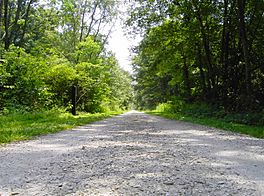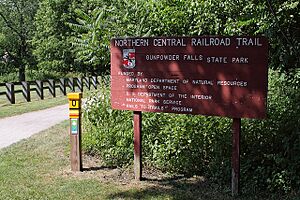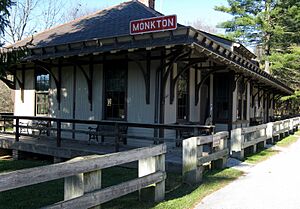Torrey C. Brown Rail Trail facts for kids
Quick facts for kids Torrey C. Brown Rail Trail |
|
|---|---|

TCB's crushed limestone surface
|
|
| Length | 20 mi (32 km) |
| Location | Ashland, MD to MD/PA border (continuing to York, PA via Heritage Rail Trail County Park) |
| Established | 1984 |
| Trailheads | Cockeysville New Freedom |
| Use | Hiking, biking, horseback riding, fishing, pet walking |
| Difficulty | Easy, level, ADA accessible |
| Season | Year-round |
| Months | Year-round |
| Surface | Crushed limestone |
| Right of way | Northern Central Railway |
| Website | https://dnr.maryland.gov/publiclands/Pages/central/tcb.aspx |
The Torrey C. Brown Rail Trail (TCB) is a special path built on an old railroad corridor. It used to be where the Northern Central Railway trains ran. This trail is 20 miles long and goes from Ashland Road in Cockeysville, Maryland, all the way to the border with Pennsylvania.
When you reach the Pennsylvania line, the Torrey C. Brown Trail changes its name. It becomes the York County Heritage Rail Trail and continues into the city of York. The trail is about 10 feet wide and has a smooth surface made of crushed stone. Most of the trail follows the Gunpowder River and Beetree Run.
Lots of people enjoy this trail for different activities. You can go horseback riding, jogging, walking, hiking, or biking. It's also a great spot for fishing. If you have a pet, they are welcome too, as long as they are on a leash. The trail is open every day, from sunrise to sunset, all year long.
The TCB is also a part of a much bigger trail system called the East Coast Greenway. This huge system of trails is 3,000 miles long and connects states from Maine all the way down to Florida!
Contents
Discover the Trail's History
What Was the Northern Central Railway?
The Northern Central Railway was built way back in 1832. It was one of the oldest train lines in the United States. This railway connected Baltimore, Maryland, to Sunbury, Pennsylvania. It operated for 140 years, helping industries in Baltimore, York, and Harrisburg grow.
The railway had 46 stops, with 22 of them in Maryland. It carried passengers, including people going on vacation to Bentley Springs. It also moved goods between Baltimore and York or Harrisburg, Pennsylvania. During the Civil War, the Northern Central Railway was super important. It moved supplies, food, clothes, and even soldiers heading south from training camps.
How the Trail Came to Be
The Northern Central Railway stopped running between Cockeysville and York in 1972. This happened after a big storm called Hurricane Agnes damaged its bridges. The old train path, or "bed," was then turned into the rail-trail in 1984. You can still see parts of the old railway today.
Along the trail, you'll find historical markers that tell its story. One cool spot is the Monkton Train Station. It has been fixed up and now works as a museum, a gift shop, and a ranger station.
Building the Trail: A Community Effort
In the early 1980s, there was a big discussion about turning the old train tracks into a trail for walking and biking. Some property owners argued that the land should go back to them. They felt that the state only took their land for train tracks, and if there were no more trains, the land should be returned.
However, the state won the argument. The Maryland Department of Natural Resources then changed the old railway path into the trail we know today. It officially opened to the public in 1984. Now, hundreds of people use the trail daily for biking, walking, and horseback riding. The trail also gives people access to the Gunpowder River and Loch Raven for boating and fishing.
In 2007, the trail was renamed the Torrey C. Brown Rail Trail. This was done to honor Dr. Torrey C. Brown. He was the third Secretary of the Maryland Department of Natural Resources and strongly supported the trail's creation.
Trail Features and Fun
Trail Design and Safety
Most of the trail's 20 miles are 10 feet wide. It has a smooth surface made of crushed limestone. This design makes the trail easy to use for everyone, including people in wheelchairs.
The start of the trail, called Mile 0, is near Maryland Route 145 (Ashland Road). There's a small parking lot there. A bigger parking lot is just a little north on Paper Mill Road. You'll find more parking spots along the trail's entire length. To keep everyone safe, the trail has warning signals, mileage markers, and old railroad signs.
What Can You Find Along the Trail?
The Torrey C. Brown Rail Trail offers many helpful things for visitors. You can find drinking fountains to stay hydrated. There are also picnic tables and benches where you can rest and enjoy a snack. Portable restrooms are available along the way too.
If you need a place to stay, there are hotels and motels close to the trail. You can also easily find a bike shop nearby that rents and fixes bikes. Besides the renovated Monkton Station, there's also the Sparks Bank Nature Center in Sparks, Maryland. It's a great place to learn about nature.
Community and Events
Who Supports the Trail?
The Maryland Department of Natural Resources, a state government agency, manages and takes care of the Torrey C. Brown Trail. They work hard to keep it in great shape for everyone to enjoy.
The Maryland Park Service has a volunteer program. They look for people who want to help maintain this trail and many others across Maryland. The trail gets money from the state and federal governments, as well as from generous donations.
Fun Events on the Trail
The Maryland Department of Natural Resources and other groups host different events every month. These events are a fun way to learn and explore. You can join in activities like looking for old artifacts or studying local plants.
There are also exciting night-time bike rides and even inner tubing events. If you're feeling really adventurous, you might even find a marathon happening on the trail!



